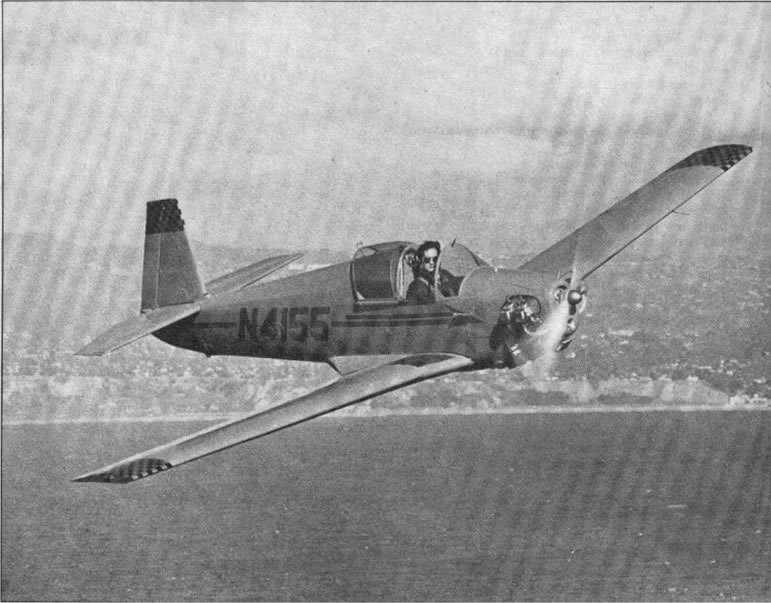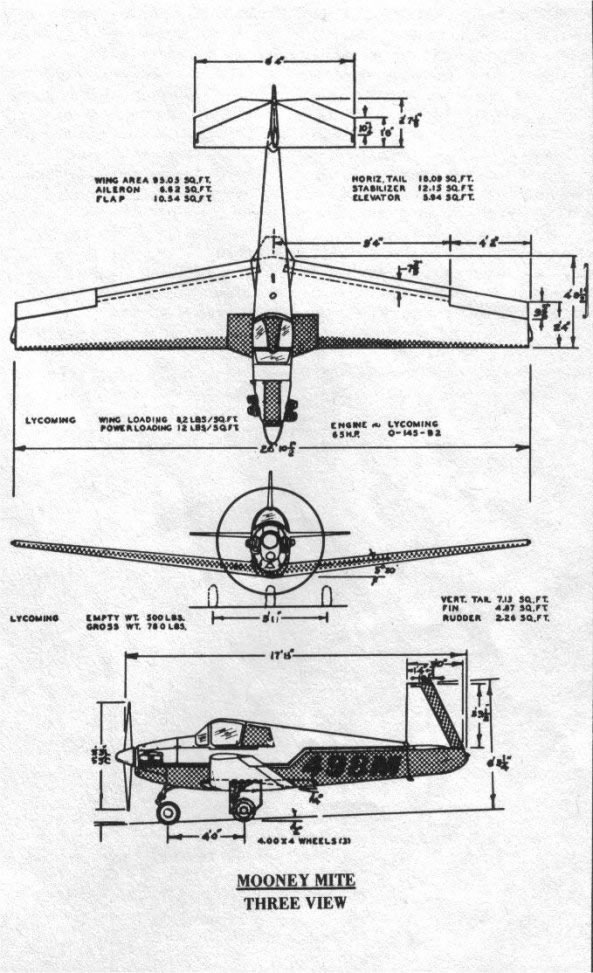
A Homebuilt Mooney Mite
by Sam Greene
This article is based on one originally published in the April, 1978 edition of Homebuilt Aircraft.

Bob Katz has flown this Mooney Mite for the past decade, enjoys sliding the canopy back to smell the fresh air.
Back in 1947, aircraft designer Al Mooney had a big idea. Returning war heroes who had flown Mustangs and similar World War II fighters against the bad guys would stand in line to buy a hot little single-seater sport plane for under $2,000, to help them withdraw slowly from their addiction to furious flying.
He developed a little cutie that weighed only 500 lbs and carried a 25-hp Crosley engine, converted from a motorcar powerplant. It so impressed a bunch of brass from the defunct Culver Aircraft Corp., who had failed to attract customers the year before with their two-seater Model V, that they formed a company to produce the M-18 Mite, as it was called.
Customers stayed away from that one, too, in droves. The builders upped the power with alternate engines, installing the 65-hp Continental A65-8 in the M-18C, and the 65-hp Lycoming O-145B2 in the M-18L. In six years they only sold 284 Mites before they got the message — there was no commercial market for the single-seater.
 |
|
Three view of the Mooney Mite shows off its racy lines that are common to the great Al Mooney. |
Nevertheless, Al Mooney had started a trend for sporty-looking, fast little jobs with the forward-swept tail-fin, still a mark of distinction today in the Mark 21 and Executive Mooneys.
In 1970 a new company, the Mooney Mite Aircraft Corp., was born to market the 1600 sq. ft. of factory plans, all type certificated, for homebuilders. Again, there was no rush to grab up a hot deal. There was something good there, however, and Fred Quarles, who had formed MMAC in 1970, launched an intensive advertising campaign in 1977 to let people know what they'd been missing - The M-18X.
It was all a matter of timing. And single-seater sport planes that were a drug on the market in the immediate postwar years suddenly became appealing. A younger generation of home-builders has come along, fellows who never flew in combat but have the urge to get into something with good performance at low cost. And what better could you ask than a design with an ATC that can get you around the country at roughly a penny a mile, and in class?
Quarles has come up with a Mooney Mite kit deal that runs a few nickels under $6,000 and includes some 4000 parts, all computer-itemized for the beginning homebuilder. Completed, the homebuilt Mite should perform as well as the M-18 production craft that set world records for speed, distance, and altitude in Class C-1a. The homebuilt version has an estimated Vmax of 143 mph TAS, a 25,000-foot ceiling, and a 600-mile range with aux tanks. She'll burn under four gph at 130 mph Cruise.
According to Quarles, the homebuilt Mooney Mite makes a top-drawer school project for four valid reasons; The building includes most current construction methods including working with metal, tubing, fabric, and doping. The craft is small enough to take up limited space in a crowded classroom. Its low cost is no big financial burden, and the fast construction timeline holds student interest high.
To find out more about the Mooney Mite mystique I looked up Bob Katz, a Santa Monica, Calif. film producer who has owned one for the past 10 years, N4155, which sports a Continental A75 powerplant.
Katz is crazy about his Mite, and is in a good position to compare performances with a number of other aircraft he's owned or flown, from a Comanche and a 210 to a Starduster Too and even a Breezy. "She's a pure joy to fly," he sums up. "She's a strap-on airplane. You don't climb into it, you wear it,"
When he bought N4155 she was in pretty sad shape, so he spent a year or so on a restoration project, including an engine major overhaul, replacement of a few wooden parts, new fabric, and paint. He's flown her 800 hours since then, including trips to such faraway places as Alaska, Canada, and intermediate points.
He installed a metal cruise propeller to make her go faster on XC jaunts and gets an honest 133-134 mph TAS at 3000 feet. For some reason she flies faster at higher altitudes. With the cruise prop she'll still climb at 500 fpm, and he's had her up to 15,000 feet. With a wooden club she'll hit book values of 1400 fpm ROC and a 15,000-foot top. In normal cruise mode, Katz' Mite burns under 4.5 gph. His tank holds 15 gallons of 80-octane juice, of which four are "in the red," safe only for straight and level flying.
N4155 was built originally in 1954 (Ser. No. 320) and has the standard manually-retractable Mooney gear that accounts for much of her speed. The flaps, as in all Mites, are mechanically linked to the horizontal stabilizer so that the ship stays in trim at any flap setting, up to 30 degrees.
Like the original Mite, Katz' has the checkerboard plaid design on the tail and wingtips, an idea Al Mooney dreamed up to advertise its economy as a "Wee Scotsman."

Bottom view of Bob Katz' Mite reveals how its wheels tuck up inside wing, also wide span flaps, wing ailerons.
Although not acrobatic, it's stressed to +3.8 Gs and is perfectly safe to rat around the sky in so long as you don't get ham-handed. A few have lost their tails, so the FAA slapped a mandatory AD fix on her.
Katz, who has logged some 2000 hours and is an Instrument-rated SELA driver, painted his Mite a blood red so you can't miss it at the local gas pump. But then, the Mites are so distinctive they'd stand out in a sandstorm.
For the homebuilder, it's comforting to know the Mite is one of the very few type-certificated do-it-yourself flying machines in the air today. Much of its performance comes from clean lines, like the low-wing, fully-cantilevered, wood-and-fabric construction. Airfoil is of the laminar-flow variety, from NACA 64-415 at the tips to 63-215 at the roots.
Grossing 780 lbs and weighing only 505 lbs empty, the Mite, powered with wing loading of 8.21 lbs/hp and a power loading of 12.0 lbs/hp. Useful load is 275 lb; baggage capacity, 40 lb max. Wing flaps span 70 per cent of the trailing edge, with a total area of 10.54 sq. ft. Ailerons have 6.22 sq. ft. of area and are very responsive, says Katz.

Homebuilt Mooney Mites carry approved Type Certification of their design, and provide excellent XC speed and economy.
Fuselage is all metal at the cabin station; the rest is of welded 4130 chrome-moly tubing skinned with either aluminum or fabric. Tail is of laminated wood construction, fabric covered. While the main wing spar is of laminated wood, of torsion box construction, all control surfaces are of welded steel frame, fabric covered. Control surface gaps are sealed. You won't be alone in the sky in your homebuilt Mite; there's a Mooney Mite Owners Association with 149 registered members who keep in touch through a MMOA newsletter edited by Quarles. MMOA membership is $10 a year, with headquarters at Dept. XR-478, P.O. Box 3999, Charlottesville, Va. 22903, telephone (804) 296-7711, also the address of the Mooney Mite Aircraft Corp. An info kit costs $8.95 and a set of M-18X plans, 10 times that, or $89.95. Total kit price is $5,995.
  |
The most recent Mooney Mite Fly-In was staged last September at Porterville, Calif., when nine Mites showed up, five from Southern California. (We ran into Bob Katz at the Chino Fly-In last year, and so became intrigued with his little beauty.) Some fantastic journeys have been made in Mites, like the one in which Al Mooney celebrated his 25th anniversary as an airplane designer. He flew nonstop more than 1300 miles, averaging 35 mpg at a ground speed of 122 mph, for less than one copper penny per mile!
In 1952 another Mite established a world class distance record at 1364 miles, more than doubling the former class mark for planes weighing under 1103 lbs. And they still talk about a nonstop journey a Mite made from California to Hawaii in the belly of a USAF C-124, but that was cheating.
Over the years inflation has upped the costs of all homebuilts, but today, where can you get as much fun for under $6,000 (plus powerplant) than in this fast, economical, fun-to-fly midget by Al Mooney?
We should point out that Fred Quarles' MMAC and MMOA are now defunct. The Mooney Mite Site, which now acts as the primary source for all information about the M-18s, still get inquiries about M-18X kits. [25 November, 2004]
We have an e-mail update for you from Bob Katz: "I've owned the 4155 since '68. Total time is about 3300. I have about 2700 in it myself. I probably fly it 50-75 hours per year now. I haven't made a lot of long cross countries in the last 10 years. usually 1hr each way kind of flights. It is just a joy to fly and even though I fly a lot of other aircraft (also own a Comanche), it still is the most fun. It's been basically trouble free except for the usual age related issues (brake cables breaking, etc.)." [26 November, 2004].
2004-11-30